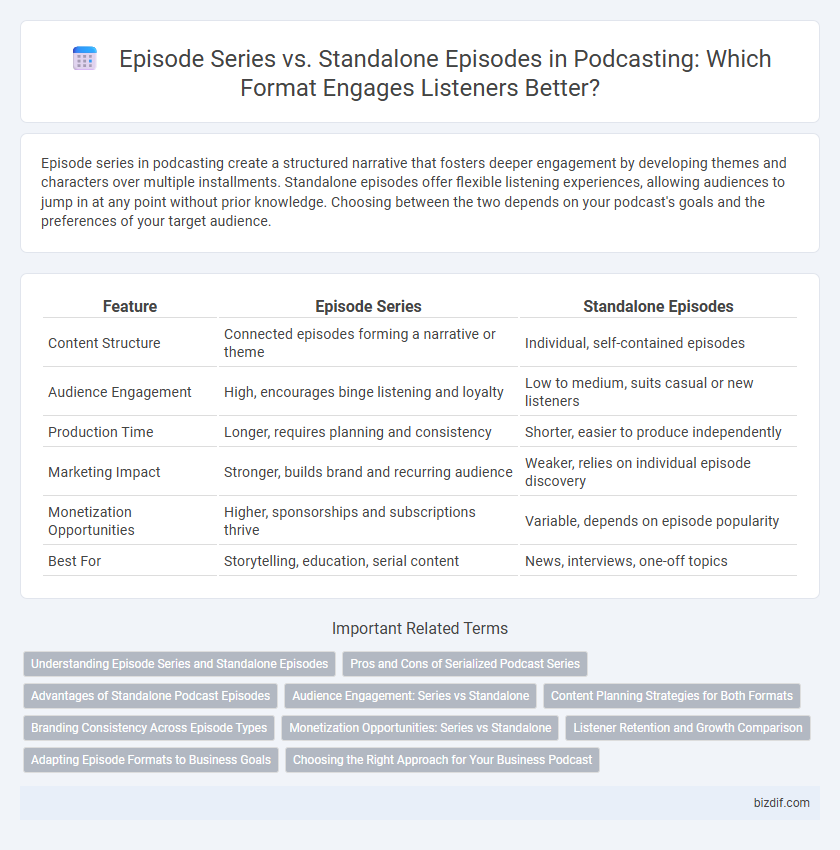Episode series in podcasting create a structured narrative that fosters deeper engagement by developing themes and characters over multiple installments. Standalone episodes offer flexible listening experiences, allowing audiences to jump in at any point without prior knowledge. Choosing between the two depends on your podcast's goals and the preferences of your target audience.
Table of Comparison
| Feature | Episode Series | Standalone Episodes |
|---|---|---|
| Content Structure | Connected episodes forming a narrative or theme | Individual, self-contained episodes |
| Audience Engagement | High, encourages binge listening and loyalty | Low to medium, suits casual or new listeners |
| Production Time | Longer, requires planning and consistency | Shorter, easier to produce independently |
| Marketing Impact | Stronger, builds brand and recurring audience | Weaker, relies on individual episode discovery |
| Monetization Opportunities | Higher, sponsorships and subscriptions thrive | Variable, depends on episode popularity |
| Best For | Storytelling, education, serial content | News, interviews, one-off topics |
Understanding Episode Series and Standalone Episodes
Episode series consist of multiple interconnected episodes that explore a specific topic or narrative arc in-depth, often encouraging listener retention and sustained engagement. Standalone episodes deliver self-contained content with a clear beginning and end, making them accessible without prior knowledge of previous content. Understanding the differences helps podcasters tailor content strategies to audience preferences and improve reach and impact.
Pros and Cons of Serialized Podcast Series
Serialized podcast series offer deep narrative arcs that enhance listener engagement by developing characters and themes over multiple episodes, fostering loyal audiences. They enable creators to explore complex stories with higher production value but require consistent release schedules and commitment from listeners, which can limit casual or drop-in audience growth. However, serialized formats risk alienating new listeners if previous episodes are missed, making discoverability and accessibility more challenging compared to standalone episodes.
Advantages of Standalone Podcast Episodes
Standalone podcast episodes offer listeners immediate value without the commitment to a full series, enhancing accessibility and attracting a broader audience. Each episode can target specific topics or keywords, boosting search engine optimization and discoverability. This format allows creators to experiment with diverse content styles and adapt quickly to listener feedback.
Audience Engagement: Series vs Standalone
Episode series foster higher audience engagement by cultivating loyal listeners who return for consecutive content, enhancing anticipation and fostering community discussions. Standalone episodes attract casual listeners seeking specific topics, offering flexible entry points without commitment, but may yield lower repeat audience rates. Balancing series continuity with standalone accessibility optimizes reach and deepens listener investment across diverse audience preferences.
Content Planning Strategies for Both Formats
Episode series offer structured storytelling and thematic continuity, enabling deeper audience engagement through serialized content that builds anticipation and loyalty. Standalone episodes provide flexibility, catering to topical discussions and diverse subjects, which appeals to casual listeners and broadens audience reach. Effective content planning balances recurring themes in series with timely or varied standalone topics, optimizing both listener retention and episode discoverability.
Branding Consistency Across Episode Types
Episode series in podcasting create a cohesive narrative that strengthens brand identity through recurring themes, hosts, and formats, fostering listener loyalty and recognition. Standalone episodes offer flexibility and variety, allowing brands to showcase diverse topics while maintaining core elements like intro music, voice tone, and visual branding for consistency. Balancing series and standalone episodes enhances audience engagement without diluting brand presence across different content types.
Monetization Opportunities: Series vs Standalone
Episode series generate higher monetization opportunities through sustained audience engagement, attracting long-term sponsors and enabling subscription models. Standalone episodes offer flexibility for quick ad placements and diversified content monetization, but typically yield lower revenue per episode. Consistent series growth enhances listener loyalty, increasing potential for premium content sales and branded partnerships.
Listener Retention and Growth Comparison
Episode series in podcasting tend to drive higher listener retention by fostering ongoing engagement through narrative continuity and thematic consistency. Standalone episodes appeal to casual listeners but often result in lower growth rates due to limited audience investment across episodes. Data shows series-based podcasts achieve 30% greater subscriber growth and 25% longer average listening durations compared to standalone formats.
Adapting Episode Formats to Business Goals
Adapting episode formats to business goals offers distinct advantages: episode series build audience loyalty through consistent, thematic content that drives long-term engagement, while standalone episodes provide flexibility and targeted messaging ideal for promotional campaigns or topical discussions. Businesses focused on brand building benefit from serialized storytelling that deepens listener connection, whereas those prioritizing lead generation may find standalone episodes deliver concise, high-impact calls to action. Aligning episode formats with marketing objectives maximizes return on investment by tailoring content delivery to strategic goals.
Choosing the Right Approach for Your Business Podcast
Episode series provide structured storytelling and foster audience retention by delivering consistent content around specific themes, ideal for building brand authority in niche markets. Standalone episodes offer flexibility and accessibility, making them suitable for addressing diverse topics or attracting casual listeners without requiring commitment to a sequence. Selecting the right approach depends on business goals, target audience preferences, and the desired depth of engagement to maximize impact and listener loyalty.
Episode Series vs Standalone Episodes Infographic

 bizdif.com
bizdif.com